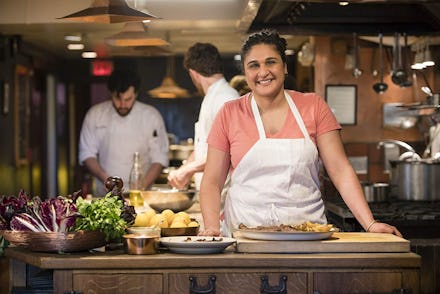‘Salt Fat Acid Heat’ is the perfect antidote to those viral cooking videos

One of Netflix’s many October releases is a subdued food and travel docuseries, Salt Fat Acid Heat, hosted by chef Samin Nosrat and based on her award-winning cookbook of the same name. The show’s four episodes follow Nosrat as she explores each of the four essential elements of great food (hence the title) and travels to Italy, Japan and Mexico.
Despite being an accomplished chef and columnist for New York Times Magazine, Nosrat was hardly a household name before her Netflix show — but Salt Fat Acid Heat seemed to become everyone’s favorite show shortly after its Oct. 11 release.
The pure joy with which Nosrat approaches cooking and eating is part of what makes the series such a delight to watch — and helps make it the perfect refuge from an always-brutal news cycle. It also provides a welcome antidote to the viral cooking videos that have dominated your Facebook feed for what feels like an eternity.
You know the ones: the overhead, POV-style cooking videos that show dishes being prepared in hyper-speed. The style was popularized by BuzzFeed’s wildly popular Tasty series, but has since spread to a whole host of near-identical iterations from various publishers, including Tastemade, CookingLight and Best Bites. A quick scroll through these Facebook pages unveils a bunch of recipe “hacks,” like using premade ingredients or baking bread in a slow cooker.
Those videos are a little bit like the junk food they often incorporate — fun as an occasional treat, but too much of them will make you feel sick. There’s something about watching countless versions of disembodied hands making wacky food combos like “sloppy Joe egg rolls” that can feel a little soulless after awhile.
That’s part of what makes Salt Fat Acid Heat the complete opposite of viral food videos. In the show, there are certainly shots of hands making food, but they’re not disembodied. They belong to Nosrat, and the camera follows both her hands and her face as she slowly kneads focaccia dough, harvests olives for oil or eats sashimi sprinkled with salt.
In fact, much of what Nosrat makes, eats and observes over the course of the series is beautifully simple. Unlike the Frankenstein food mashups that make good fodder for viral videos — a video of chicken Alfredo lasagna was one of Tasty’s most-watched in 2017 — Salt Fat Acid Heat is interested in foods that have just a few ingredients. Sometimes there are only two, like grilled chicken brushed with traditional soy sauce or pasta made by cracking eggs into a delicate nest of flour.
The show is also intensely interested in the cultural context that gives rise to food, another welcome departure from viral cooking videos, most of which have no narration, likely because they’re designed to be watched without sound as viewers scroll through social feeds. They don’t have the time to explain ingredients or history, or where egg rolls come from and why someone might want to stuff them with sloppy Joe mixture.
For contrast, Salt Fat Acid Heat pairs its stunning visuals with Nosrat’s essential narration as she explains the history of the foods she’s learning about. Many of the food experts she speaks to are older women who’ve been honing their craft for decades — an intentional choice meant to highlight the foundational role women have played in developing cooking around the world. In one episode, Nosrat visits a woman who makes miso in clay pots, burying them in the ground, sometimes for years.
Perhaps best of all, Salt Fat Acid Heat shows the actual eating, an element usually missing from viral cooking videos. It’s clear the end goal for Nosrat is the perfect bite, actually putting the food in your mouth versus just seeing the finished product. Throughout the series, we see her eat buttery pork fat, lick raw salt sprinkled over soft serve ice cream and bite into a piece of cheese so good it actually brings her to tears.
While viral food videos are ubiquitous and can feel corporate, Salt Fat Acid Heat is all heart and tastebuds. And there are only four episodes, so it’s enough to satisfy — but not so much it doesn’t leave you hungry for more.